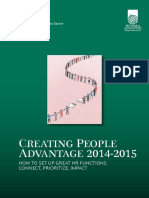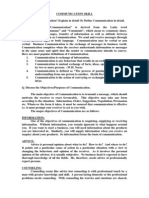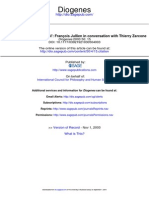Work On Strengths or Weaknesses?: Benefits of A High-Impact Learning Culture
Work On Strengths or Weaknesses?: Benefits of A High-Impact Learning Culture
Uploaded by
Poonam NaiduCopyright:
Available Formats
Work On Strengths or Weaknesses?: Benefits of A High-Impact Learning Culture
Work On Strengths or Weaknesses?: Benefits of A High-Impact Learning Culture
Uploaded by
Poonam NaiduOriginal Title
Copyright
Available Formats
Share this document
Did you find this document useful?
Is this content inappropriate?
Copyright:
Available Formats
Work On Strengths or Weaknesses?: Benefits of A High-Impact Learning Culture
Work On Strengths or Weaknesses?: Benefits of A High-Impact Learning Culture
Uploaded by
Poonam NaiduCopyright:
Available Formats
// I n fo g r a p h //
Benefits of a High-Impact Learning Culture
Based on responses from 426 organizations, the Bersin & Associates study “High-Impact
Learning Culture: The 40 Best Practices for Creating an Empowered Enterprise” found that
leadership and management play a pivotal role in learning culture, and most best practices
focus on informal approaches to learning, which further reinforces the need to expand the
concept of "learning" well beyond formal training.
Of all organizations with strong learning cultures:
46%
34% 33% 39%
18%
46% are more likely to 34% are more likely 18% are more likely 33% are more likely to 39% are more likely
be strong innovators in to get to market to be a market-share report higher customer to report success
their markets before competitors leader satisfaction than other implementing customer
organizations suggestions
Source: Bersin & Associates
// Fa s t Fact //
Work on Strengths or Weaknesses?
One of the basic questions facing everyone creating Leaders believe that they know their weaknesses and their
a personal development plan is whether to focus strengths, but according to the report, “people are not accu-
attention on correcting faults or building strengths. rate in their perception of their weaknesses or their strengths.
The answer to the question depends on the competencies Using 360-degree feedback ensures that people have more
of the person involved, and those can vary over time accord- accurate data, which provides both guidance and motivation
ing to a new report, “Developing Strengths or Weaknesses: in the improvement process.”
Overcoming the Lure of the Wrong Choice,” by Jack Zenger, Zenger Folkman data on tens of thousands of leaders
CEO and co-founder of Zenger Folkman. shows that
The report analyzed more than 6,000 leaders on the dimen- • 64 percent have no strengths
sion of possessing strengths or weaknesses (fatal flaws), and • 11 percent have only one strength
from there, arranged the leaders into three categories: those hav- • 15 percent have from two to five strengths
ing one or more fatal flaws, those having neither strengths nor • 10 percent have six or more strengths.
weaknesses, and those leaders having one or more strengths. “If you possess a profound weakness, then work on that,”
“Those leaders who have fatal flaws should not spend time Zenger explains. “Working on strengths is relatively futile
working on developing strengths,” notes Zenger. According to until that is rectified. Once the
the report, it is extremely important to first correct the obvi- serious weakness is correct-
ous flaw. Therefore, for one-third of the leader population, the ed, instantly begin to work
focus should be on identifying the weakness and fixing it. on developing strengths.
“Much of our work in counseling, coaching, and behavioral It is the presence
therapy has been to get people who are in negative territory of a handful of
up to ground zero,” says Zenger. “We can’t overemphasize strengths that will
the need to get that done. But never forget that such work make you the strong
only gets you to ground zero. Now the focus has to be on the leader your organi-
“positive deviance” side of the equation where the real payoff zation needs.”
comes. That is when building strengths come into play.”
Photo by Shutterstock.com august 2010 | T+D | 23
Copyright of T+D is the property of American Society for Training & Development and its content may not be
copied or emailed to multiple sites or posted to a listserv without the copyright holder's express written
permission. However, users may print, download, or email articles for individual use.
You might also like
- Ethics and The Conduct of BusinessDocument166 pagesEthics and The Conduct of BusinessBuddah Kush86% (14)
- Korn Ferry High Potential Ebook Chapter 1Document17 pagesKorn Ferry High Potential Ebook Chapter 1Henry Wijaya100% (2)
- High Potential IdentificationDocument18 pagesHigh Potential IdentificationNafizAlamNo ratings yet
- celta-TP7 - LessonplanDocument7 pagescelta-TP7 - Lessonplanshilpadub100% (3)
- All About History Ancient History's Lost Cities - 2018Document148 pagesAll About History Ancient History's Lost Cities - 2018cjltn12324100% (12)
- Current Novellas - Why Novellas - PDFDocument7 pagesCurrent Novellas - Why Novellas - PDFManuel Pulido MendozaNo ratings yet
- Zfa Strengths or WeaknessesDocument4 pagesZfa Strengths or Weaknessesapi-226060323No ratings yet
- Succession MattersDocument36 pagesSuccession MattersAlejandro Velásquez Rivas100% (1)
- Internalizing Strengths: An Overlooked Way of Overcoming Weaknesses in ManagersFrom EverandInternalizing Strengths: An Overlooked Way of Overcoming Weaknesses in ManagersNo ratings yet
- Owning Success: Six Choices That Empower Underrepresented Talent To AchieveDocument20 pagesOwning Success: Six Choices That Empower Underrepresented Talent To AchieveJaya AbrahamNo ratings yet
- Advocacy Vs Mentoring White PaperDocument7 pagesAdvocacy Vs Mentoring White PaperEvgenia SorokinaNo ratings yet
- 10 Principles of Strategic LeadershipDocument9 pages10 Principles of Strategic LeadershipbillpaparounisNo ratings yet
- Kilberry High Potential WhitepaperDocument3 pagesKilberry High Potential WhitepaperAna Maria Sotomayor ChiappeNo ratings yet
- Vitalize your Workplace: Conquering the Crisis of Employee StagnationFrom EverandVitalize your Workplace: Conquering the Crisis of Employee StagnationNo ratings yet
- Diversity and Inclusion: 7 Best Practices For Changing Your CultureDocument7 pagesDiversity and Inclusion: 7 Best Practices For Changing Your CulturedarhebachechildrenNo ratings yet
- Korn Ferry Institute RealWorldLeadership Report 2Document28 pagesKorn Ferry Institute RealWorldLeadership Report 2Vincent De Marassé EnoufNo ratings yet
- High Potential Employees H07i7d-Pdf-EngDocument11 pagesHigh Potential Employees H07i7d-Pdf-EngManu LNo ratings yet
- Succession Matters: Effective Succession Management PlanningDocument16 pagesSuccession Matters: Effective Succession Management PlanningHeymi SifuentesNo ratings yet
- AngliskiDocument7 pagesAngliskijstojanov19No ratings yet
- Building a Winning Culture In Government: A Blueprint for Delivering Success in the Public SectorFrom EverandBuilding a Winning Culture In Government: A Blueprint for Delivering Success in the Public SectorNo ratings yet
- Korn Ferry High Potential Ebook Chapter 1Document17 pagesKorn Ferry High Potential Ebook Chapter 1Gricelda HaroNo ratings yet
- Eliminate Bias in DevelopmentDocument5 pagesEliminate Bias in Developmentnestor.nicollperuNo ratings yet
- The ASTD Management Development Handbook: Innovation for Today's ManagerFrom EverandThe ASTD Management Development Handbook: Innovation for Today's ManagerNo ratings yet
- Rapid Transition SuccessDocument15 pagesRapid Transition SuccessNajjahul ImtihanNo ratings yet
- Six Myths About Empowering Employees PDFDocument5 pagesSix Myths About Empowering Employees PDFnagam abhishekNo ratings yet
- Empowering Employees & Teams For High PerformanceDocument3 pagesEmpowering Employees & Teams For High PerformanceAhmed MohamedNo ratings yet
- 8 Essential Qualities That Define Great LeadershipDocument4 pages8 Essential Qualities That Define Great LeadershipDavidNo ratings yet
- The Myth of The Ideal Worker Does Doing All The Right Things Really Get Women AheadDocument24 pagesThe Myth of The Ideal Worker Does Doing All The Right Things Really Get Women AheadNina RungNo ratings yet
- Innovation Prowess: Leadership Strategies for Accelerating GrowthFrom EverandInnovation Prowess: Leadership Strategies for Accelerating GrowthNo ratings yet
- Feedforward Analysis Report Lidia Hadley 1Document35 pagesFeedforward Analysis Report Lidia Hadley 1Cristian NechitaNo ratings yet
- Leadership Succession Planning Affects Commercial Success''Document3 pagesLeadership Succession Planning Affects Commercial Success''Zain NabiNo ratings yet
- White Paper-Authentic Leadership-By Stuart ConstableDocument13 pagesWhite Paper-Authentic Leadership-By Stuart ConstableStuart ConstableNo ratings yet
- Developing A Positive Emotional Life TranscriptDocument21 pagesDeveloping A Positive Emotional Life Transcriptyannis7No ratings yet
- Understanding Power. at The Core of The Concept of Empowerment Is The Idea of PowerDocument2 pagesUnderstanding Power. at The Core of The Concept of Empowerment Is The Idea of PowerWalker Adan Rios RojasNo ratings yet
- The American Review of Public Administration-2006-Marsh-382-4Document4 pagesThe American Review of Public Administration-2006-Marsh-382-4Zadok AdeleyeNo ratings yet
- Creating An Execution CultureDocument4 pagesCreating An Execution CulturesprathNo ratings yet
- Selecting Leadership TalentDocument48 pagesSelecting Leadership TalentinfoNo ratings yet
- 10 Reasons Why You Should Develop High Potential EmployeesDocument3 pages10 Reasons Why You Should Develop High Potential EmployeessamNo ratings yet
- Wipro's Way: Ranjan AcharyaDocument6 pagesWipro's Way: Ranjan AcharyaAnjan DasNo ratings yet
- How to Be Exceptional: Drive Leadership Success By Magnifying Your Strengths: Drive Leadership Success By Magnifying Your StrengthsFrom EverandHow to Be Exceptional: Drive Leadership Success By Magnifying Your Strengths: Drive Leadership Success By Magnifying Your StrengthsRating: 5 out of 5 stars5/5 (1)
- 3 Ways To Foster A HCD Workforce ExperienceDocument1 page3 Ways To Foster A HCD Workforce Experiencejinal_shahNo ratings yet
- HRSG Develop Transformational Leaders Using CompetenciesDocument15 pagesHRSG Develop Transformational Leaders Using CompetenciesAhmed Al-TaherNo ratings yet
- Challenges and Opportunities Being Faced by Leaders EssayDocument5 pagesChallenges and Opportunities Being Faced by Leaders EssayVanessa GoinsNo ratings yet
- Enhancing 360-Degree Feedback for Senior Executives: How to Maximize the Benefits and Minimize the RisksFrom EverandEnhancing 360-Degree Feedback for Senior Executives: How to Maximize the Benefits and Minimize the RisksRating: 1 out of 5 stars1/5 (1)
- 2013 Building The Right High Potential Pool White PaperDocument18 pages2013 Building The Right High Potential Pool White Paperjunaid100% (1)
- Great Man TheoriesDocument9 pagesGreat Man TheoriesWiljohn de la CruzNo ratings yet
- Unleashing The Human Element at Work Transforming Workplaces Through RecognitionDocument40 pagesUnleashing The Human Element at Work Transforming Workplaces Through RecognitioncindyNo ratings yet
- What Leadership Skills Do You Need For 2022Document26 pagesWhat Leadership Skills Do You Need For 2022riteshkarunakarNo ratings yet
- OB EmpowermentDocument27 pagesOB EmpowermentPratik MohapatraNo ratings yet
- BestBuddies Employing People With Intellectual and Developmental Disabilities I4cp 2014Document36 pagesBestBuddies Employing People With Intellectual and Developmental Disabilities I4cp 2014ted knowlesNo ratings yet
- Active Learning Projects1 of Ch1Document8 pagesActive Learning Projects1 of Ch1kabolfetohNo ratings yet
- How The Best Bosses Interrupt Bias On Their TeamsDocument7 pagesHow The Best Bosses Interrupt Bias On Their TeamsBenedictNo ratings yet
- Nine Behaviors That Drive InnovationDocument4 pagesNine Behaviors That Drive InnovationThaís Pezzotti DutraNo ratings yet
- 7 Communication Do's and Don'ts For Leaders Facing Rapid Organizational ChangeDocument10 pages7 Communication Do's and Don'ts For Leaders Facing Rapid Organizational ChangeAnshumali Saxena100% (1)
- Five Secrets of High Performing OrganizationsDocument14 pagesFive Secrets of High Performing OrganizationsSkip Reardon100% (11)
- Turning the Pyramid Upside Down: A New Leadership ModelFrom EverandTurning the Pyramid Upside Down: A New Leadership ModelNo ratings yet
- Truth About TrustDocument16 pagesTruth About TrustYosra OuertaniNo ratings yet
- Basic of Potential Management PDFDocument94 pagesBasic of Potential Management PDFHass MamacheNo ratings yet
- Leap of ReasonDocument179 pagesLeap of ReasonMauricio RojasNo ratings yet
- Basic of Potential ManagementDocument94 pagesBasic of Potential ManagementHass MamacheNo ratings yet
- Hire Your Dream Team: 10 Secrets to Recruiting Star TalentFrom EverandHire Your Dream Team: 10 Secrets to Recruiting Star TalentNo ratings yet
- The Finesse Factor: How to Build Exceptional Leaders in STEM OrganizationsFrom EverandThe Finesse Factor: How to Build Exceptional Leaders in STEM OrganizationsNo ratings yet
- 52 148 Midterm Answer (Spring 2003 - 2004)Document4 pages52 148 Midterm Answer (Spring 2003 - 2004)Poonam NaiduNo ratings yet
- Data Science TalkDocument1 pageData Science TalkPoonam NaiduNo ratings yet
- Product and Brand ManagementDocument317 pagesProduct and Brand ManagementPoonam Naidu100% (3)
- Crime Rate Data DescriptionDocument2 pagesCrime Rate Data DescriptionPoonam NaiduNo ratings yet
- Dmgt518 Training and Development SystemDocument253 pagesDmgt518 Training and Development SystemPoonam NaiduNo ratings yet
- Dcap302 Dcap514 Enterprise Resource PlanningDocument233 pagesDcap302 Dcap514 Enterprise Resource PlanningPoonam Naidu100% (1)
- Hay Group Next Generation HR Research Report PDFDocument16 pagesHay Group Next Generation HR Research Report PDFPoonam NaiduNo ratings yet
- Facilitation The BasicsDocument26 pagesFacilitation The BasicsPoonam NaiduNo ratings yet
- Chapter 1 F14Document7 pagesChapter 1 F14Poonam NaiduNo ratings yet
- BCG HRDocument40 pagesBCG HRPoonam NaiduNo ratings yet
- Kolkata and North-East Centre at Tezpur: Indian Statistical InstituteDocument1 pageKolkata and North-East Centre at Tezpur: Indian Statistical InstitutePoonam NaiduNo ratings yet
- Social Movement OrganizationsDocument19 pagesSocial Movement OrganizationsPoonam NaiduNo ratings yet
- Linear Algebra: Column Vector DimensionDocument10 pagesLinear Algebra: Column Vector DimensionPoonam NaiduNo ratings yet
- UCINET 6 User's GuideDocument47 pagesUCINET 6 User's GuidePoonam NaiduNo ratings yet
- Simple Linear Regression: ParametersDocument34 pagesSimple Linear Regression: ParametersPoonam NaiduNo ratings yet
- Structural Equivalence: Roles & PositionsDocument7 pagesStructural Equivalence: Roles & PositionsPoonam NaiduNo ratings yet
- Review of Basic Probability and Statistics: Random VariableDocument55 pagesReview of Basic Probability and Statistics: Random VariablePoonam NaiduNo ratings yet
- Accomplishment Report IN Empowerment Technologies (Etech) 2016-2017Document6 pagesAccomplishment Report IN Empowerment Technologies (Etech) 2016-2017karen a escobidoNo ratings yet
- Crisis at The BorderDocument4 pagesCrisis at The Bordershannonsmith94No ratings yet
- Where Is The Middle East? The Definition and Classification Problem of The Middle East As A Regional Subsystem in International RelationsDocument21 pagesWhere Is The Middle East? The Definition and Classification Problem of The Middle East As A Regional Subsystem in International RelationsJoão Fernando FinazziNo ratings yet
- Evaluare Initiala Copil (PT Parinte) - Copil Nonverbal Sau Preverbal - EnglezaDocument2 pagesEvaluare Initiala Copil (PT Parinte) - Copil Nonverbal Sau Preverbal - EnglezaRoxana GogiuNo ratings yet
- Communication SkillDocument26 pagesCommunication Skillalirrehman100% (9)
- Report Writing 1 & 2Document12 pagesReport Writing 1 & 2Vineeth KuruvathNo ratings yet
- 9C A Day in The Life' of An ArchitectDocument2 pages9C A Day in The Life' of An Architectsri priyanka kathirvelNo ratings yet
- Helping Intermediate Learners With Multiword VerbsDocument22 pagesHelping Intermediate Learners With Multiword VerbsMattFlemingNo ratings yet
- Holliday - Native SpeakerismDocument3 pagesHolliday - Native SpeakerismDánisaGarderesNo ratings yet
- Lesson Plan: Department Topic Class Course Vocational Pedagogy Three Phase Induction Motor EET-EM-7 AVP-3Document5 pagesLesson Plan: Department Topic Class Course Vocational Pedagogy Three Phase Induction Motor EET-EM-7 AVP-3api-282628079No ratings yet
- Architectural Design Theory: Semester IDocument30 pagesArchitectural Design Theory: Semester IAman SharmaNo ratings yet
- Kaikorai Primary School: N e W S L e T T e RDocument6 pagesKaikorai Primary School: N e W S L e T T e RKaikorai_SchoolNo ratings yet
- Unit 11 Conserving NatureDocument10 pagesUnit 11 Conserving NaturePatricia Sanchez Migallon BlancoNo ratings yet
- Introduction To CommDocument12 pagesIntroduction To Commmunir houseNo ratings yet
- Graphology - 1st PartDocument4 pagesGraphology - 1st PartMohammad Jaid AlamNo ratings yet
- Towards A Theory of Good History Through GamingDocument25 pagesTowards A Theory of Good History Through Gamingελένη αποστολίδουNo ratings yet
- Francois Jullien, "China As A Philosophical Tool"Document8 pagesFrancois Jullien, "China As A Philosophical Tool"HelgeSnorri100% (1)
- Budi Waluyo ResumeDocument5 pagesBudi Waluyo ResumeChairun NisaNo ratings yet
- Primary Source and Reading Guide - Medieval Christian EuropeDocument2 pagesPrimary Source and Reading Guide - Medieval Christian Europekolbe1walshNo ratings yet
- StylisticsDocument2 pagesStylisticsLilit KishmiryanNo ratings yet
- If Not HigherDocument4 pagesIf Not Highersaru.sd124No ratings yet
- The GiftedDocument2 pagesThe GiftedKimberly MilanteNo ratings yet
- Stream of ConsciousnessDocument3 pagesStream of ConsciousnesssafiaNo ratings yet
- Project TemplateDocument10 pagesProject Templateapi-323099162No ratings yet
- LoadingDocument12 pagesLoadingLuz Anne de GuzmanNo ratings yet
- 3rd Quarter Exam in MAPEH 9Document5 pages3rd Quarter Exam in MAPEH 9Rodel Capalad100% (3)










































































































